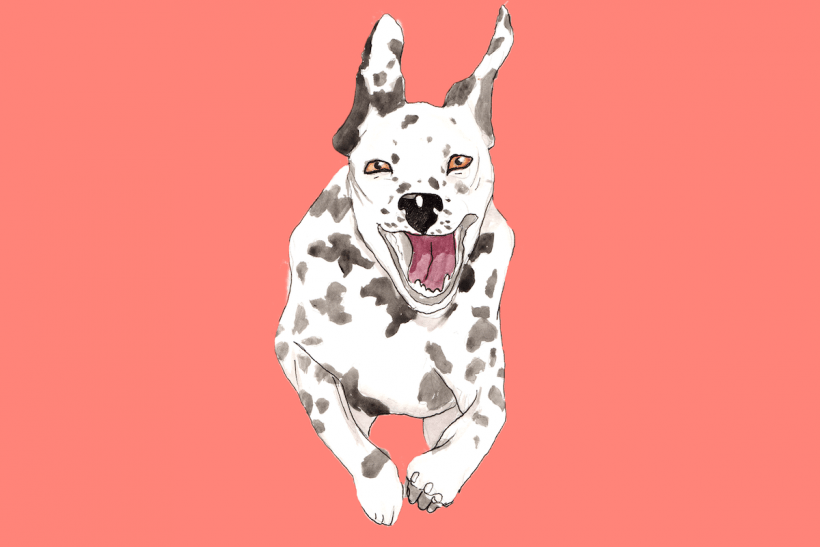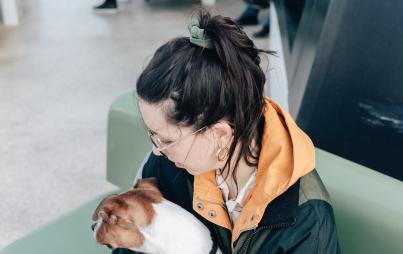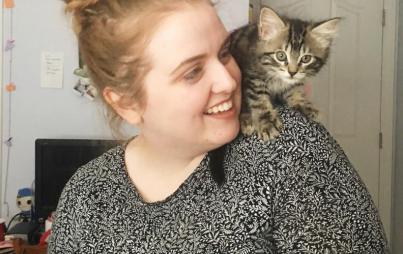
It’s so easy to let animals into your heart — take it from the woman who has 14 — but what happens if your heart is big, but your home is small?
When I decided to bring home a two-month-old Dalmatian puppy — the size of an adult cat, sleepy all the time, soft as fleece — to my one-bedroom apartment in October 2016, my best friend said, "You’re making a big mistake. He’s going to be miserable."
She was wrong: he isn’t. But for a while, I was. Scholar is part wildebeest, leaping over coffee tables and sliding into walls. He’s happy as only a dog can be, but what was I thinking, bringing a Dalmatian into a 650-square-foot space?
I was thinking that owning a Dalmatian had been my dream since I was four. I was thinking I could use the company. Hamsters, hermit crabs, fish, and turtles are great — but they can’t compare to a dog.
I was not thinking of space.
Apartment living is ideal for many things in my life — like being walking distance from work or adhering to a grad student’s budget — but turns out, puppy-parenting isn’t one of them. Of course, I knew my third-story apartment wouldn’t be suitable for an adult Dalmatian. But Scholar is just a baby, I reasoned. I’d be moving to a bigger place in less than a year. I told my disgruntled friend, "He won’t be full-grown until we move."
It didn’t matter. Half-grown was still too big.
I should note that Dalmatians aren’t even that large, as far as dogs go. My friend has a Labrador puppy the same age as Scholar, and he has consistently weighed nearly double my dog’s weight their entire lives (60lbs at six months when Scholar only weighed 30, 90lbs at one year when Scholar was 50). Not to mention the extra-large breeds: Saint Bernards, Great Danes, Newfoundlands. Dalmatians are solidly medium-sized dogs.
What made Scholar feel gigantic was our living space.
Many people might own bigger dogs, but they (probably) also own bigger homes. Everything in my apartment had to be tiny. The kitchen table (which was in the living room, since my kitchen couldn’t accommodate a dining table) was a small circular thing with only two chairs — like what you might see on a coffee shop patio. My desk doubled as a plant stand, a bookshelf, and a feeding area for my cat. I was already using most of the free space I had to house a 55-gallon turtle tank, rabbit enclosure (under the desk), and birdcage. My TV was on my bookshelf because I didn’t have space for a separate stand. There wasn’t room for even a recliner. Everything had to be compact. So, by the laws of relativity, Scholar grew into a giant.
I was prepared to take him to dog parks, through hiking trails, on long walks in my neighborhood — but that didn’t change the fact that I needed to find a way to live with him when we were inside.
The night I brought him home was perfect: he slept in a cat bed and couldn’t even reach the couch without help. He had puppy breath and velvet ears and could fit any place with room to spare.
In less than two months, he grew a head taller than my coffee table, where I ate most of my meals. Turn your back for a second and that peanut butter sandwich was nowhere to be found, just a puppy with a suspiciously sticky mouth.
A month after that, he could reach the kitchen counter on his hind legs, so beware bags of chips left unattended!
Once, hearing skateboarders outside, Scholar ran to the window— OMG a visitor, I love visitors! — to stand up on his back legs and look outside, but he didn’t have room to fit between the kitchen chair and the window, so he hit the table and knocked over a potted plant, spilling the soil and exposing the roots. He looked surprised. Oops, sorry!
The next week, when I was pouring his food into a bowl, Scholar did a happy dance — OMG dinner, I love dinner! — wagging his whole butt, and backed into his cage in my bedroom, hitting my nightstand and knocking over a glass of water with his tail. Oops, sorry!
And every day after that, every time I was trying to read, Scholar — OMG you’re on the couch, I love the couch! — ran across the room at full speed and leaped onto the cushions without looking, landing on my poor unsuspecting sleeping cat, more pillow than feline. Oops, sorry!
I know much of this just comes with raising a puppy, and I’m not complaining — I knew the energy attributed to his breed meant that he'd have springs for legs and an antelope's personality. I was prepared to take him to dog parks, through hiking trails, on long walks in my neighborhood — but that didn’t change the fact that I needed to find a way to live with him when we were inside. For a dog bred for stamina and speed, is it possible to make such a snug place feel spacious?
You Might Also Like: Why You Should Go Ahead And Give Your Dog Table Scraps
Some people might say no. They might think it’s cruel to keep a dog like this in an apartment. But I have found that not only is it possible, there are also so many benefits to living in such close quarters with my dog I wouldn’t change the first year of Scholar’s life for anything.
It just requires a little creativity. Instead of resisting Scholar’s wildebeest ways, I learned to lean into the curve.
I removed one of the chairs from the table so Scholar could stand on his back legs and look out the window, watching over the neighborhood as he liked. This was something he was going to do anyway, and making room for him to stand meant a lot less soil for my vacuum to get up. Plus, the uff-uff-uff sound he makes, like barking under his breath, is so cute.
Next, I rehomed my actual wooden nightstand and moved his crate beside my bed, where it functioned as a replacement. I put my clock, phone charger, and other nightstand things on top of it, so I didn’t lose the convenience of a bedside table. But now Scholar has room to get in and out of his crate without maneuvering around an additional piece of furniture. This meant a lot less spilled cups, with the added comfort of being able to hear him breathe while we slept.
Finally, I taught Scholar to lay in the hammock I had strung over my couch — and our lounging space doubled in size. When he got the hang of climbing into it, he could snooze the afternoon away, leaving the couch free of his Laffy-Taffy-long legs. This meant a significantly less-squished kitty, and more cuddles for me.
As I said, it’s easy to let animals into our hearts — but not always easy to make room for them in our spaces.
It might mean losing a chair or your part of the couch or a piece of furniture you’ve had since college. And never having bathroom privacy again, or losing most of your mattress to a dog that sleeps legs extended and a cat that hogs the pillows. But living in so snug a place with animals — getting to know their heartbeats, furry smells, happy sounds — more than makes up for anything broken, spilled, or squished.








